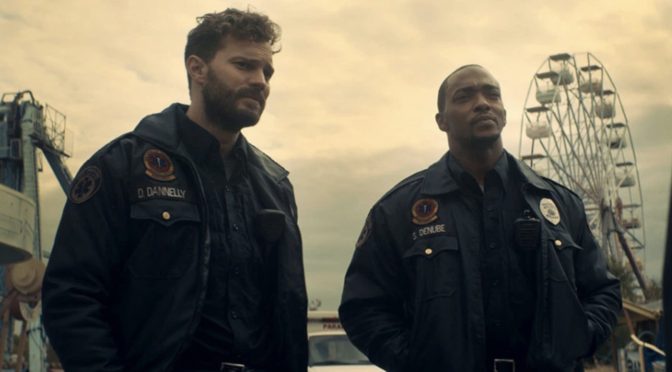SYNCHRONIC joins the dense history of time travel films with an intriguing mechanic and clear character motivations to attach to it. However, Benson and Moorhead’s film zips by at a pace that means our attachment to those characters never develops the film into the emotionally engaging feature it could have been.
Anthony Mackie leads as Steve, a paramedic in New Orleans who works alongside Dennis (Jamie Dornan). The city is seeing a wave of strange overdose incidents due to a new designer drug, Synchronic. When Dennis’s daughter, Brianna, goes missing, seemingly due to an incident with the drug, Steve looks to investigate. After determining Synchronic allows you to travel back in time, Steve sets out to use it to bring Brianna back as his final crusade in the face of failing health.
The time travel mechanics are often the thing that will tip the balance for this type of film. Needlessly complex rules suck out intrigue and emotion from the film, whereas overly-simplistic ones can seem convenient or fail to bolster the film’s thematic undercurrents. SYNCHRONIC’s mechanics find that sweet spot, and Benson and Moorhead do an excellent job of showing how these work by taking us on a journey with Steve as he figures it all out via what can only be deemed to be the scientific method. This approach means having the odd mini-monologue to the camera he is recording his observations on, but it sidesteps the need for too much exposition. Instead of sucking away from the character motivations, it instead develops Steve’s dedication, whilst also contrasting against his hitherto lack of commitment to the present. What exposition the film does have is quite elegantly framed, such as the vinyl record analogy for how time travel and the Synchronic drug works.
The time-travel occurs only in time and not space, so this opens up avenues of commentary in the script by having a modern-day Black man travel to the past of America’s South. Leaving this to expand organically based on the period Steve finds himself in, as well as setting up tense but surprising comparisons to other time periods, is an effective way to develop elements hinted at in the film’s opening (where Steve is ridiculously mistaken for a potential criminal by a white police officer arriving at the scene). It’s a pointed explanation for Steve’s apathy and apparent burnout, tying it directly to his experience of existing in the modern American South and the role the region’s history of slavery and colonialism linked to that experience plays.
Unfortunately, the film doesn’t spend enough time letting us understand Steve’s emotional investment alongside his clear logistical objectives. It’s telling that a moment involving his pet dog is more affecting than anything involving Brianna or Dennis. The film’s tight running time leaves this angle comparatively starved for attention, and empathy levels generated by the film suffer for it. Still, there are enough intelligently-approached ideas to keep SYNCHRONIC engaging and smart.

